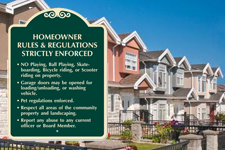 *Asked & Answered
*Asked & Answered
Asked – Fallen and decayed vegetables from a homeowner’s garden are attracting numerous rats and other pests. With the new law permitting personal food gardens, is there anything our HOA can do to address this issue?
Answered – Probably. AB 2561, effective January 1, 2015, added Section 1940.10 and 4750 to the Civil Code. In sum, Section 4750 grants homeowners within HOAs the right to use their backyards for “personal agriculture,” regardless of any provisions contained in a HOA’s governing documents to the contrary. However, that right is not absolute. HOAs still have some authority to restrict and regulate personal food gardens in the following respects:
- Personal Use/Donation Only – The crops must be grown for personal use or donation. Crops grown for sale or other commercial purposes do not fall within the definition of “personal agriculture” for the purposes of Section 4750.
- No Marijuana or Unlawful Substances – There is no right for a homeowner to grow “marijuana or any unlawful crops or substances,” as those items do not constitute a “plant crop” permitted by Section 4750.
- Only on Owner Property or Exclusive Use Common Area – The right to keep and maintain personal food gardens extends only to the owner’s backyard or areas designated for the exclusive use of the homeowner (i.e., exclusive use common area patios), not general HOA common areas.
- Reasonable Restrictions Permitted – The HOA may still impose “reasonable restrictions” on the use/maintenance of homeowner’s yard for personal agriculture. “Reasonable restrictions” are those that “do not significantly increase the cost of engaging in personal agriculture or significantly decrease its efficiency.”
- Clearance of Dead Plant Materials and Weeds – Section 4750 still allows for HOAs to apply rules and regulations requiring that “dead plant material and weeds, with the exception of straw, mulch, compost and other organic materials” that encourage vegetation and soil moisture retention, be regularly cleared from the backyard. A rule or regulation requiring such clearance may be successful in resolving your rodent and pest problem.
As indicated above, the right to have a personal food garden would not necessarily insulate a homeowner from his obligation to comply with related provisions of a HOA’s governing documents that serve as “reasonable restrictions” on the use of a yard for personal agriculture. For example, virtually every set of CC&Rs contains a provision prohibiting homeowner from conducting any activity on their property that poses a nuisance to neighboring homeowners. If the way in which a homeowner’s food garden is being maintained is resulting in a nuisance (i.e., attracting rats and other pest populations), the nuisance provision would likely constitute a “reasonable restriction” that the HOA may enforce against the homeowner.
|
In addition to the issues noted above, HOAs may, in some instances, have the authority to restrict food gardens that violate other provisions of the Association’s governing documents that serve as “reasonable restrictions” allowable under Section 4750 (i.e., a height limitation within the HOA’s landscaping standards may serve to prohibit crops that grow to unreasonable heights). HOA Boards that are encountering problems with food gardens should consult with their legal counsel for guidance as to how their governing documents may be tailored to address these types of issues. |
To submit questions to the HOA attorneys at Tinnelly Law Group, click here.
 HOA Lawyer Blog
HOA Lawyer Blog


 *New Legislation
*New Legislation Most every set of Homeowners Association (“HOA”) CC&Rs contain a provision prohibiting conduct which constitutes a “nuisance.” That conduct often includes “noxious, illegal or offensive activities,” anything which “unreasonably interferes with a resident’s right to quiet enjoyment” and/or “endangers their health or annoys or disturbs” them. We have blogged about how such nuisance provisions may be employed to resolve issues such as the
Most every set of Homeowners Association (“HOA”) CC&Rs contain a provision prohibiting conduct which constitutes a “nuisance.” That conduct often includes “noxious, illegal or offensive activities,” anything which “unreasonably interferes with a resident’s right to quiet enjoyment” and/or “endangers their health or annoys or disturbs” them. We have blogged about how such nuisance provisions may be employed to resolve issues such as the  *New Legislation
*New Legislation *New Legislation
*New Legislation
 *Asked & Answered
*Asked & Answered *Asked & Answered
*Asked & Answered We recently
We recently  *New Legislation
*New Legislation